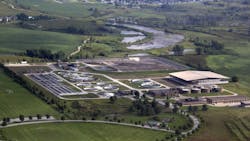Plant Profile: Iowa City South Wastewater Plant
Six years after Iowa City, Iowa, made a $50.2 million expansion of its South Wastewater Treatment Plant to address a number of concerns, city officials are noting a number of benefits from its moderinzation.
The project was completed in May 2014, two years after construction began. Upon its construction, the project was believed to position Iowa City for the future. It has fulfilled those goals, said Steve Flake, assistant superintendent.
The expansion was a long time coming, as city management had sought to move all of its wastewater operations out of the city core for years. When the city had two treatment plants – the North Plant and the South Plant – the North Plant was located alongside the Iowa River.
With many wastewater treatment plants in the U.S. located in flood-prone regions, closing the aging downtown plant served to mitigate the risk of sewage release during flooding. A flood in 2008 that inundated the city’s North Wastewater Treatment Plant accelerated efforts when untreated sewage flowed into the Iowa River, causing the plant to be temporarily shut down and almost completely lost.
“It was very, very prone to getting flooded,” Flake said, adding the project has reduced that risk.
Plant Expansion Helps Address Efficiency Goals
The wastewater treatment plant was expanded to accommodate biological removal of total nitrogen and total phosphorus.
The expansion not only enabled the plant to comply with the state’s nutrient reduction strategy, but provides for future capacity for residential and industrial customers. Since the plant’s expansion, the city’s population has grown by up to 4%, Flake said.
The design treatment capacity of the facility is 24.2 million gallons per day (mgd), with a maximum daily capacity up to 43.3 mgd.
To address efficiency and sustainability goals, the expansion included the state’s first bio-augmentation reactor system to decrease the amount of tank space necessary for treatment and reduce the high concentrations of ammonia produced by the treatment process.
“We used to have chlorine gas and sulfur dioxide for dechlorination,” said Flake. “One of the big improvements was when we went to ultraviolet disinfection.”
That helped to mitigate potential hazards from chemical transportation and use. The city took advantage of funding sources – a USDA loan and local bonding – to finance the improvements, Flake added.
Multiple goals were attached to the project: improvements in safety, sustainability and energy efficiency, and paving the way for Iowa City’s economic growth and future development.
With the project having doubled the South Plant’s treatment capacity to 24.2 mgd, it paved the way for increased city growth while meeting strict ammonia limits. It also reduced high ammonia concentrations from digested sludge dewatering.
Choosing the Right Treatment Plant Equipment for Success
The treatment plant project included the addition of two secondary clarifiers, the extension of four drains in the aeration basin, a primary clarifier, and three new influent pumps.
The use of enhanced system controls, high speed blowers to more efficiently match process air requirements as well as influent pump adjustments resulted in a reduction of energy needed to reduce the overall pump lift required to move water into the treatment system.
In terms of safety, old equipment such as hoists were upgraded to current standards.
The expansion incorporated surface film waste and skimming, and return-activated sludge chlorination with hypochlorite to keep the foam, scum and filamentous blooms from a nearby manufacturing operation under control.
The project combined two plants and two discharge points into one plant and one discharge point, and was executed without additional impact to the Iowa River. Currently, Iowa City’s advanced treatment plant consists of 17 lift stations and 300 miles of sanitary sewer pipe throughout the city. The treatment plant staff measures and reports daily on 13 different parameters to the Iowa Department of Natural Resources for influent and effluent.
While the plant was treating an average of 10 mgd of wastewater daily, it has gone down to about 7.5 mgd due to a collection system lining project, Flake said. Wet weather flow is 43 mgd with average dry weather flow of 23 mgd. The city has also paid off the project-related loan.
“We are considered debt-free,” said Flake. “We’ve still got room to grow. We’re going to be able to go out into the collection system and do more maintenance and possibly bring down our flows even farther and do some upgrades from when the plant was originally built back in 90s. We’re moving forward with some small projects throughout the plant to modernize it.”
That will include new return activated sludge pumps for the secondary clarifiers, Parshall flumes for the inflow pump station to better monitor the flow and larger turbo blowers to replace some centrifugal blowers.
“We're going to be moving forward with a DC-driven mixer from Flygt that we predict is going to save us about $600,000 over a 20-year period,” Flake added.
Location: Iowa City, Iowa
Size: 24.2 mgd average; 43.3 mgd max
Equipment: clarification, aeration, influent pumps, bio-augmentation reactor, blowers, disinfection, controllers
About the Author
Carol Brzozowski
Carol Brzozowski is a freelance writer for Wastewater Digest. Brzozowski can be reached at [email protected].
